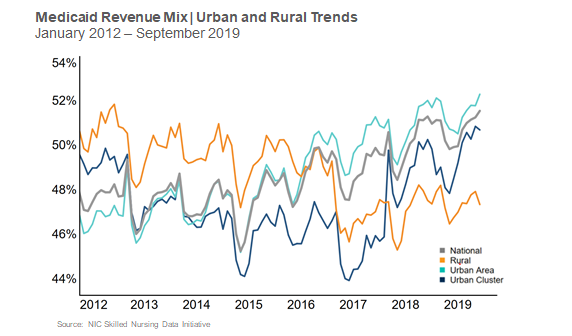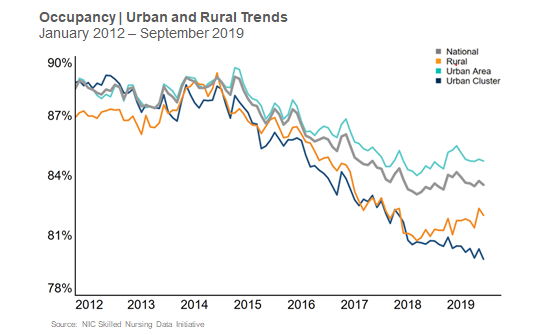- Medicaid revenue mix reached a time-series high
- Occupancy flat, continues to stabilize
NIC released its third quarter 2019 Skilled Nursing Data Report last week, which includes key monthly data points from January 2012 through September 2019.
Here are some key takeaways from the report:
- Medicaid revenue mix reached a time-series high of 51.5% in the third quarter 2019, up 55 basis points from the second quarter of 2019 and up 25 basis points from a year ago. The quarterly revenue trend was driven by the urban areas, as it increased from the prior quarter and from the prior year, but the rural area Medicaid revenue mix was down slightly from the prior quarter and lower from the same period last year. Although the lowest payor in terms of revenue per patient day (RPPD), Medicaid RPPD also hit a time-series high ending the third quarter 2019 at $214. It grew 0.7% quarter-over-quarter and 2.4% year-over-year. However, the yearly RPPD growth still trails nursing home wage growth by a wide margin.

- The skilled nursing occupancy rate was flat from the second to third quarters of 2019 at 83.6%. Monthly occupancy continues to show stabilization and has averaged 83.6% since falling to its low point of 83.1% in June 2018. Year-over-year occupancy increased 21 basis points and is up 48 basis points from June 2018. The trend differed by geographic location as occupancy increased quarter-over-quarter in rural areas, remained flat in urban areas, and decreased in urban cluster areas.

- Skilled mix hit a time-series low in the third quarter of 2019. The decrease was mostly driven by Medicare, although managed Medicare patient day mix decreased quarter-over-quarter as well. Historically, this is not uncommon as the data does usually show a decrease from the second to the third quarter. However, the fact that skilled mix has now hit a time-series low suggests that there is still general downward pressure on skilled admission and/or length of stay. Skilled mix decreased 50 basis points from the second quarter 2019 to end the third quarter 2019 at 24.4%. It also decreased from the prior year, falling 39 basis points. Skilled mix increased by 12 basis points in rural areas from the prior quarter to end the third quarter at 22.6%. The urban areas saw a 67 basis point decline quarter-over-quarter to end at 25.0%. On a year-over-year comparison, skilled mix in both urban and rural areas decreased.
- Medicaid patient day mix hit a time-series high of 67.6% in the third quarter as it increased 56 basis points from the prior quarter. The fact that skilled mix decreased 50 basis and occupancy was relatively flat in the third quarter suggests that Medicaid demand is helping to stabilize occupancy. Medicaid patient mix increased 62 basis points year-over-year. The quarterly Medicaid patient day mix increase was driven by both urban and rural areas, which increased 70 basis points and 58 basis points, respectively, from the second quarter. Meanwhile, private patient day mix continues to decrease as it fell 5 basis points from the prior quarter to end the third quarter 2019 at 8.0%. It was down 23 basis points from a year ago.
To get more trends from the latest data, download the NIC Skilled Nursing Data Report here. There is no charge for this report.
The report provides aggregate data at the national level from a sampling of skilled nursing operators with multiple properties in the United States. NIC continues to grow its database of participating operators in order to provide data at localized levels in the future. Operators who are interested in participating can complete a participation form on nic.org. NIC maintains strict confidentiality of all data it receives.
About Bill Kauffman
Senior Principal Bill Kauffman works with the research team in providing research and analysis in various areas including sales transactions and skilled nursing. He has lead roles in creating new and enhanced products and implementation of new processes. Prior to joining NIC he worked at Shelter Development in investing/acquiring, financing, and asset management for over $1 billion in assets. He also had key roles in the value creation and strategic planning and analysis for over 65 entities. He received his Bachelor of Business Administration in Finance from the College of Business and Economics at Radford University and his Master of Science in Finance from Loyola College in Maryland. He also holds the Chartered Financial Analyst Designation (CFA).
Connect with Bill Kauffman
Read More by Bill Kauffman